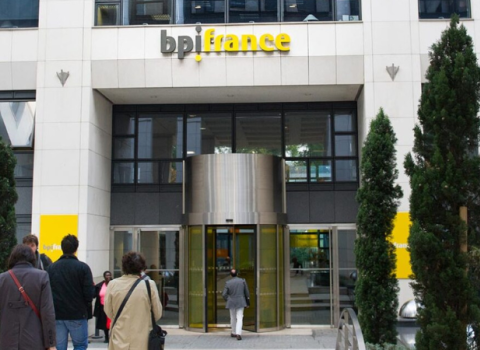As the EU Defence Innovation Scheme takes shape, questions remain about gaps and barriers in Europe’s defence innovation ecosystem.

Photo: NATO
Suddenly, it seems, everyone cares about Europe’s defence innovation ecosystem. NATO is setting up the Defence Innovation Accelerator for the North Atlantic, or DIANA, with a significant presence in Europe. The European Commission is working on the EU Defence Innovation Scheme, EUDIS. And last month, Amazon Web Services announced it is setting up a private defence accelerator in the UK.
But details of the DIANA and EUDIS initiatives have been slow to emerge, leading to concerns that gaps and barriers to innovation remain to be addressed. EUDIS in particular leaves a lot of questions unanswered.
“It’s a step in the right direction, but whether it is enough is deeply debatable,” said Nicholas Nelson, senior fellow with the Transatlantic Defense and Security Program at the Center for European Policy Analysis in Washington DC. “And this will not be figured out in the next year or two. It will take five or ten years to see what the impact is.”
This sentiment is echoed by Alain De Neve, a specialist in defence innovation at Belgium’s Royal Higher Institute for Defence. “EUDIS is a timely initiative for the EU member states, although from a macro-strategic point of view there is still a long way to go for Europeans if they want to build a competitive research ecosystem on a more global scale,” he said.
Detecting hidden threats
EUDIS is intended to bring together all relevant EU initiatives that support defence innovation and entrepreneurship. This includes innovation-focused calls for proposals issued through the European Defence Fund (EDF), such as a planned technological challenge to test and mature technologies for hidden-threats detection, and a four-year partnership for the development of defence medical counter measures against chemical, biological, radiological and nuclear threats.
The Commission also plans a number of initiatives intended to structure the European defence ecosystem. Some of these are still frustratingly vague. There is to be a dual-use incubator to allow better spin-in and spin-out between the civil and defence sectors, and to spur technological maturation and adaptation. This project was first floated in the EU’s 2021 Action plan on synergies between civil, defence and space industries, which suggested it might be a virtual network based on close collaboration between the Commission, the European Innovation Council and the European Defence Agency.
At that stage, the incubator’s potential activities included screening EU-funded research for results relevant to defence and proposing them for follow-up funding or user uptake. It was also to support new technologies with dual-use potential coming from start-ups, SMEs, and research and technology organisations. But these details and partners have vanished from the latest description of the incubator, and the Commission says it has nothing more to add while preparations are on-going.
Detail is also still lacking on the cross-border innovation networks listed as part of the EUDIS toolbox. These are intended to test the relevance of technologies from the civil sector in defence-specific environments. Then there will be other supporting measures for innovative companies, such as matchmaking with primes, investors and end users; business coaching; and the organisation of hackathons.
Defence Equity Facility
The most concrete EUDIS initiative unveiled so far is the Defence Equity Facility, which is intended to address the lack of risk capital in the EU for start-ups and small and mid-size companies developing innovative defence technologies. The Commission will put €100 million into the facility over the next five years, which is expected to be augmented by the European Investment Fund and private investors to reach a total of €500 million.
“Enabling a better access to equity funding for innovative defence SMEs and mid-caps would support their growth and finally benefit to the innovativeness of the European defence technological and industrial base,” the Commission says in the latest EDF work programme, released on 25 May. “It will also reduce their exposure to non-EU investors and benefit to the EU’s strategic autonomy.” The creation of the facility is also intended to send a positive message to private investors that the EU’s defence sector is an attractive proposition.
Nelson thinks the Defence Equity Facility is a good start, but again a lot of important detail is still missing, such as how and on what terms the equity will be awarded. An enlightened choice would be to make non-dilutive investments, the approach used by Air Force Ventures in the US. “It is not taking equity, it is investing alongside private capital investors, because it views this as good for the ecosystem,” Nelson said.
But Nelson is also concerned that the facility potentially appears open to all-comers, rather than targeting start-ups and companies with a civilian background moving into defence. If confirmed, this will limit its impact.
For example, a seed round for a defence start-up might typically be around €2 million, with €500,000 from the Commission contribution required to lead the round. So, if the facility is focused exclusively on this early stage investment it might support 40 companies a year, which is modest enough. But if the facility gets involved in series A and B rounds, which might run to €5-7 million per round, its reach will be severely constrained. “To be honest, it needs to have another zero on the end per annum to have a catalysing effect,” said Nelson.
Gundbert Scherf, co-founder and managing director of Helsing, a German start-up active in artificial intelligence and software-defined defence, thinks this lack of focus is already holding back EDF. “Only 8% of EDF funds to date have been allocated to disruptive technologies. Consortiums primarily feature traditional primes instead of deep tech disruptors, who actually invest their own money into de-risking tech and hiring the right talent,” he said. “In reality we need to spend the majority of funds on disruptive technologies and empower new defence companies that are developing them. Only this will deliver the innovation, disruption, speed, and quality we need.”
Dual-use technologies
Another aspect of EUDIS that is unclear is how it will line up with NATO’s DIANA initiative. This was launched in April, with a mission to bring industry, start-ups and academia together to research new dual-use technologies. Initially it will run a network of more than 10 accelerator sites and over 50 test centres in innovation hubs across NATO alliance countries. The UK and Estonia will host DIANA’s European accelerators. Meanwhile, a complementary NATO Innovation Fund will invest €1 billion in early stage start-ups and other deep tech funds, over an unspecified period of time.
The Commission says that it will work with NATO “to ensure that we can develop synergies when and where possible”. De Neve thinks this may not be so straightforward. “It would be difficult to imagine that these two cooperation frameworks could operate without any exchange between them,” he said. “However, and to the extent that DIANA assumes the contribution of the US, it seems difficult to imagine interactions between these two institutions that do not clash with the restrictive measures put in place by the US in terms of transfer of sensitive technologies.”
Meanwhile there are other issues in Europe’s defence innovation ecosystem that remain to be addressed. Nelson highlights the administrative burden that companies face when applying for support, for example from the European Space Agency, a prime source of dual-use technology. “On average, ESA takes five times as long as NASA to award an early stage contract, from the time proposals are due to the time the money is in the company’s account. And on average, ESA’s awards are 40% the size, so you are waiting five times as long for far less money. That results in start-ups, especially in space and other dual-use areas, looking to open up in the US,” Nelson said.
This is an effect Nelson has seen at first hand as a mentor to start-ups in the sector, and as an angel investor. “Just reducing the administrative burden on start-ups trying to go into the European defence ecosystem, as well as reducing the timelines, would be hugely beneficial. If your awards are too small, if they take too long, and you are forcing start-ups or commercial companies to hire specialist consultants to navigate the process, that becomes less and less of an attractive value proposition,” he said.
Civilian innovators
For De Neve, the big challenge for EUDIS will be persuading civilian companies to cross over into defence. “It is precisely in the civil sector that we find most of the innovations that interest states today in terms of defence: artificial intelligence, advanced materials, big data, nanotechnologies, to name just a few,” he said. “It is therefore necessary to remove the barriers - and there are many - that constrain the establishment of dialogue and effective cooperation between the civilian and military sectors.”
These barriers can be technical, cultural and financial. “Technologies designed for civilian applications are never transposable as such in the military field,” De Neve said, citing advanced electronics as particularly challenging. “Components must withstand cyber-attacks, be hardened against jamming, and demonstrate higher resistance under particularly severe operational conditions.”
Then there is the pace and culture of innovation in the military sector. “Unlike the civil/commercial market, the defence market does not allow big returns on investment. Moreover, development cycles are long. All these factors make the defence goods market unattractive to investors. It is precisely at this level that an initiative such as EUDIS is interesting and timely.”
Enter Amazon
The defence accelerator launched by Amazon Web Services (AWS on 26 May is naturally a more modest proposition than the EU and NATO initiatives, but it too aims to help start-ups across the civilian-military divide. It offers a four-week technical, business, and mentorship programme to start-ups with cloud-based solutions for land, air, maritime, space, or cyber defence. It is open to UK-based start-ups, and those from Europe, the Middle East and Africa doing business in the UK. The first deadline is on 1 July.
“The AWS Defence Accelerator aims to connect with SMEs which have not considered the defence space a viable market before,” said Daniel Korski, chief executive of Public, the government technology firm that is delivering the accelerator for AWS. “By convening those who understand how the UK’s defence market works, and the challenges it faces, alongside those whose solutions can actively make a difference, our ambition is for the accelerator to widen and deepen the pool of talent and innovation UK defence requires.”
He also sees a gap in the defence ecosystem for an initiative that can move start-ups along quickly. “DIANA and other key initiatives are a remarkable step in the right direction, but these things do take time to determine. We very much hope that participants in the AWS Defence Accelerator are able to contribute to, and benefit from, innovation initiatives both in the UK and at an international level.”
Elsewhere in the Ecosystem…
- Polish internet-of-things start-up Kontakt.io is to receive €12 million from the European Investment Bank, to support its work applying artificial intelligence to digital building services in locations such as hospitals and hybrid workspaces. The investment, focused on the company’s R&D site in Krakow, is intended to contribute to balanced local development and digital cohesion in the region.
- Finland has introduced a two-week fast track service for start-up founders and their families who want to set up in the country. The service, launched on 1 June, comes with a new visa (for those who need one) that enables travel to Finland as soon as a residence permit has been granted and identity proven. And rather than wait for residence cards to be delivered abroad, they can be picked up on arrival. The process also applies to tech workers and other specialists with jobs waiting for them in Finland.





 A unique international forum for public research organisations and companies to connect their external engagement with strategic interests around their R&D system.
A unique international forum for public research organisations and companies to connect their external engagement with strategic interests around their R&D system.